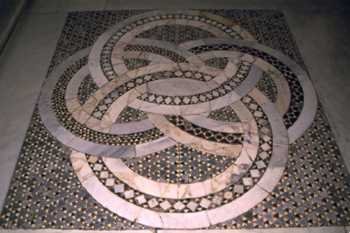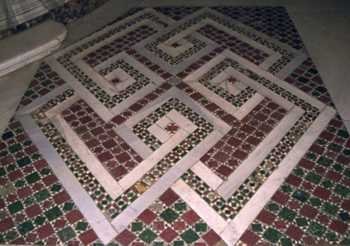

![]()
Throughout the Basilica di Santa Maria Maggiore, Cosmati tilings decorated the floor. We were fascinated with these designs and the photographs below are examples of some of the beautiful designs we found inside this church. Due to the overlapping lines, the overall shapes are examples of cyclic finite figures. Behind these shapes are intricate wallpattern designs. For each photograph, we will classify the finite figure and the wallpatterns in that picture. The Cosmati design shown in the photograph below has six rotations and no reflections. Therefore it is classified as a cyclic group of order 6. The pattern of hexagons and triangles behind this figure is a wallpattern with six-fold rotation and mirror symmetry. Thus, it is classified as p6m.

This particular Cosmati design is classified as a cyclic group of order 2. Ignoring the color of the red and green squares, this pattern is classified as a p4m wallpattern. The frieze that surrounds the entire design has both horizontal and vertical reflections. Therefore it is classified as an F7, or SPINNING JUMP.

Since this Cosmati shape is formed in a rectangle, this design is also classified as a cyclic group of order 2. Since there is three-fold rotation and mirror line, the wallpattern behind the circles is classified as p3m1. This design is also related to the fractal, the Sierpinski Triangle.

If we assume that this shape is also formed in a rectangle, it is also classified as a cyclic group of order 2. Since the wallpattern behind the diamond has four-fold rotation and reflections in four directions, it is classified as a p4m wallpattern. Noticing that the frieze in the diamond has both horizontal and vertical reflections, it is classified as an F7, or SPINNING HOP.
